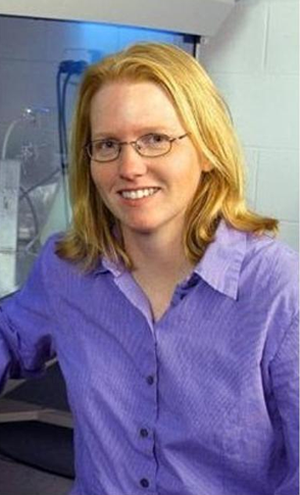A chemical engineer by training, Kristi Anseth says she has always been drawn to research with medical relevance and was especially intrigued by the evolving field of tissue engineering. "This is the quintessential engineering problem," Anseth explains. "Designing polymers that can serve as cell scaffolds requires control on many size scales—from molecules to cells to functional subunits of cells to tissues and organs to the entire human body—and on many time scales—from a fraction of a second to several months."
|

|
Kristi Anseth works at the intersection of three fields—engineering, chemistry, and biology—to design polymers that imitate living tissues, with the goal of helping the body heal itself. The polymers are meant to serve as scaffolds, or templates, on which cells can grow to replace diseased or damaged body parts, including knees, hips, cartilage, and heart valves—all without the trauma of major surgery.
Anseth is developing liquid precursors that are designed to be injected into the body and then solidified with light through a process called photopolymerization, which essentially links individual molecules together, providing the strength, stability, and flexibility to grow new cells in a three-dimensional framework. All the while, the polymers would support and guide the healing of damaged tissues before gradually dissolving as natural tissue fills in.
In 2003, Kristi and her students were the first to successfully develop an injectable and biodegradable scaffold to regenerate cartilage. These scaffolds are designed to be injected into a joint, the knee, for example, along with chondrocytes, the cells that secrete cartilage. Though it is not yet ready for clinical use, such scaffolds hold promise for treating osteoarthritis, which is caused by wear and tear on the cartilage that lines joints, as well as cartilage damaged by injuries and congenital cartilage defects.
Anseth and her students are also collaborating with other investigators to engineer human heart valves. This project is proving to be more challenging because it requires the scaffold to give instructions to the cells and provide an environment where cells can communicate with each other. But the benefit to patients would be huge. Each year in the United States, an estimated 20,000 patients die of heart-valve dysfunction, and existing surgical treatments are far from ideal. They include replacing damaged valves with mechanical valves, which require patients to take blood thinners for the rest of their lives to reduce the risk of blood clots, or heart valves from pigs, which eventually wear out.
Recommended resourcesWikipedia has a nice article on Tissue Engineering. MedicalEngineer from the UK has some very interesting links.
|
